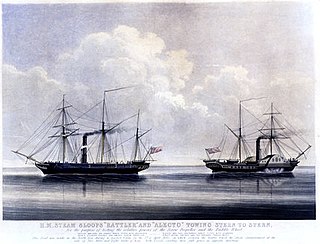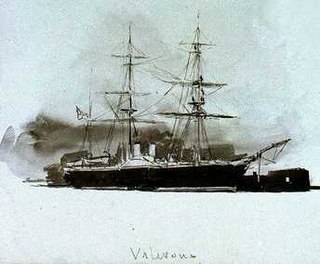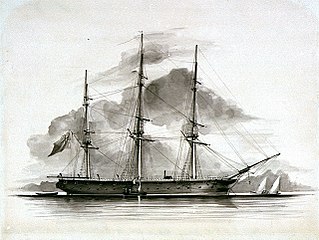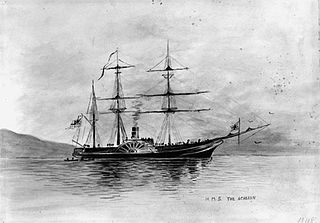
HMS Rattler was a 9-gun steam screw sloop of the Royal Navy, and one of the first British warships to be completed with screw propulsion. She was originally ordered as a paddle wheel 4-gun steam vessel from Sheerness Dockyard on 12 March 1841. She was reordered on 24 February 1842 as a propeller type 9-gun sloop from HM Royal Dockyard, Sheerness, as a new vessel. William Symonds had redesigned the ship as a screw propeller driven vessel.

HMS Miranda was a 14-gun wooden screw sloop of the Royal Navy. As part of the 1847 Program, she was designed by John Fincham, Master Shipwright of Portsmouth ,and is considered an improved Rattler, with the design approved on 3 November 1847. She was ordered on 25 April 1847 with the name Grinder from Royal Dockyard, Sheerness. On 3 November 1847, she was reordered as Miranda from Sheerness Dockyard. Launched in 1851, she was completed to see action in the Crimean War. In 1854 she was in the White Sea and participated in the bombardment of the Port of Kola. She then served in the Sea of Azov during 1855. Two of her crew were awarded the Victoria Cross for their bravery. Towards the end of her career she transported troops during the New Zealand Wars. She was reclassified as a corvette by 1862. She was sold for breaking in December 1869.

HMS Valorous was one of two 16-gun, steam-powered Magicienne-class second-class paddle frigates built for the Royal Navy in the 1850s. Commissioned in 1853 she played a small role in the Crimean War of 1854–1855 and was sold for scrap in 1891.
HMS Trident was an iron paddle sloop built for the Royal Navy by Ditchburn & Mare in 1845 at Leamouth, London. She served in the Mediterranean, off West Africa and in the South Atlantic, and was broken up in 1866.
HMS Phoenix was built as a fireship as part of the 1693–94 programme of Fireships. After her commissioning she spent time in the English Channel then joined the Fleet for the Battle of Vigo Bay followed by the Battle of Velez-Malaga. She went aground in the Isles of Scilly and was salvaged. While laid up at Plymouth in 1708 was rebuilt as a 24-gun sixth rate. After recommissioning she spent her time in Home Waters, North America and the West Indies. She was rebuilt again in 1727 before finally being sold in 1744.

HMS Niger was originally slated to be built as a Sampson designed sloop; however, she was ordered as a First-Class sloop with screw propulsion on 20 February 1845 to be built at Woolwich Dockyard, along the design developed by Oliver Lang and with a hull like the Basilisk designed paddle sloops. Her armament and engine were to be like the Encounter Design building at Pembroke. A second vessel (Florentia) was ordered on 26 March 1846 but after her keel was laid at Pembroke Dockyard, her construction was suspended on 6 October 1846 then cancelled three years later, on 22 May 1849. Niger She conducted important propulsion trials, finally proving the superiority of screw propulsion and served in West Africa, the Crimea, China, the East Indies and Australia. She took part in the New Zealand wars in 1860 and was sold for breaking in 1869.

HMS Brisk was a 14-gun wooden-hulled screw sloop designed by the Committee of Reference as part of the 1847 program. She is considered an enlarged Rattler with the design approved in 1847. She was ordered on 25 April 1847 from Woolwich Dockyard as a 10-gun sloop, but the guns were later increased due to the Russian War, to 14 guns by increasing the number of 32-pounder guns. She was launched on 2 June 1851 from Woolwich Dockyard. She served in the Russian War of 1854- 55 and as part of the Southern African anti-slavery patrol, with a final commission on the Australian Station. She was sold in 1870 for use in an pioneer, but unsuccessful, telegraph service.

HMS Salamander was one of the initial steam powered vessels built for the Royal Navy. On 10 January 1831 the First Sea Lord gave orders that four paddle vessels be built to competitive designs. The vessels were to be powered by Maudslay, Son & Field steam engines, carry a schooner rig and mount one or two 10-inch shell guns. Initially classed simply as a steam vessel (SV), she was re-classed as a second-class steam sloop when that categorization was introduced on 31 May 1844. Designed by Joseph Seaton, the Master Shipwright of Sheerness, she was initially slated to be built in Portsmouth, and was changed to Sheerness Dockyard. She was launched and completed in 1832, took part in the Second Anglo-Burmese War and was broken up in 1883.

HMS Magicienne was the lead ship of her class of two 16-gun, steam-powered second-class paddle frigates built for the Royal Navy in the 1850s. Commissioned in 1853 she played a small role in the Crimean War of 1854–1855 and was sold for scrap in 1866.

This group of vessels were originally slated to be built to the Sampson designed steam vessel; however, the Admiralty on 9 May 1845, ordered the first pair as First-Class screw sloops to be built from a design of Sir William Symonds, Surveyor of the Navy. This design would become known as the Conflict-class sloop. These would be 10-gun vessels with 400 NHP engines. The second pair of vessels were ordered on 26 March 1846 but after their keels were laid at Pembroke Dockyard, their construction was suspended in September 1846 then cancelled five years later, on 4 April 1851. Both completed ships served in the Baltic during the Crimean war, and Desperate briefly served as a store ship to Edward Augustus Inglefield's Arctic expedition. They had both been broken up by 1865.

HMS Reynard was part of the 1847 Program, she was ordered on 25 April as a steam schooner from Deptford Dockyard with the name ‘Plumper’. However, the reference Ships of the Royal Navy, by J.J. College, © 2020, there is no entry that associates the name Plumper to this build. The vessel was reordered on 12 August as an 8-gun sloop as designed by John Edye. She was launched in 1848, conducted anti-piracy work in Chinese waters and was wrecked near Pratas Island in the South China Sea on 31 May 1851.

On 26 March 1846, two vessels were ordered from Deptford Dockyard as Rifleman-designed gunvessels named Archer and Parthian. However, on 9 September 1846 the orders for both vessels were suspended prior to the vessels being laid down. On 25 April 1847 two vessels were ordered to the improved Rattler-type screw sloops as designed by John Edye of the Surveyor's Department from Deptford Dockyard. The first vessel, Archer may have been the change of the build from the Rifleman type to the sloop design. The second vessel, Wasp, appears to be a new vessel as the build for the Parthian remained on the books at Deptford until June 1849, when it was cancelled. Archer received the machinery from the gunvessel Rifleman, which resulted in an increase of speed over Wasp. Wasp's hull was sheathed in Muntz metal to retard marine growth. Their armament would increase from 12 to 15 guns over their careers. Both vessels would participate in the Russian War of 1854–1855. Both would be broken by 1869.

The Hermes class were a group of four vessels designed by John Edye of the Surveyor's Department to specifications outlined by Captain William Symonds, the Surveyor of the Navy. The design was approved in 1834. The vessels would be powered by a 140 nominal horsepower engine and carry an armament of two brass 9-pounder guns. The ships would be built in three Royal Dockyards, however, the Chatham vessel was transferred to Sheerness in 1837 prior to being laid down. Hermes was re-engined and lengthen in 1842, Megaera was wrecked in Jamaica in 1843. the remaining vessels served on many different stations of the Empire. Acheron was sold in 1855, Hermes went to the Breakers in 1864 and Volcano lasted until 1894.

HMS Dee was the first paddle steamer ordered for the Royal Navy, designed to carry a significant armament. She was ordered on 4 April 1827 from Woolwich Dockyard. She was designed by Sir Robert Seppings, Surveyor of the Navy and modified by Oliver Lang. This vessel was considered as new construction as a previous vessel ordered as a flush deck Cherokee-class brig in 1824, had been renamed African in May 1825. She was initially classed as a steam vessel (SV), and in 1837 reclassified as a steam vessel class 2 (SV2). She was converted to a troopship in May 1842 and as a second class sloop in 1846. She was converted into a storeship in 1868. She was broken at Sheerness in 1871.

HMS Hermes was a Hermes-class wooden paddle sloop of the Royal Navy. She was built at Portsmouth Dockyard. Initially she was used as apackey vessel until her guns were upgraded. She was re-engined and lengthened in 1842 to 43. She spent time on various stations in the Empire. She participated in the storming of Rangoon during the Second Burmese War. She was sold for breaking in October 1864.
HMS Medea was one of the initial steam-powered vessels built for the Royal Navy. On 10 January 1831 the new First Lord Sir James Graham, 2nd Baronet gave orders that four paddle vessels be built to competitive designs. The vessels were to be powered by Maudslay, Son & Field steam engines, carry a schooner rig and mount one or two 10-inch shell guns. Initially classed simply as a steam vessel (SV), she was re-classed as a second-class steam sloop when that categorization was introduced on 31 May 1844. Designed by Oliver Lang, the master shipwright of Woolwich. She was launched and completed in 1834, took part in the Syrian Coast Campaign and was broken up in 1867.
The Stromboli class was a group of two vessels designed by Sir William Symonds the Surveyor of the Navy. The design was approved on 29 August 1838. The vessels were of the Medea design but were altered to the new draught derived from the Gorgon. The ships were initially classified as Steam Vessels Second Class (SV2) and were later classified as First Class sloops. The ships were built in two Royal Dockyards. Both ships were at the bombardment of Acre in 1840. Both were in the Black and Azov seas during the Russian War. They served on various stations of the Empire. Vesuvius was sold in 1865 and Stromboli in 1866. Both were broken by White at East Cowes on the Isle of Wight.
The Alecto-class steam vessels (SV3) later reclassed as Third Class Sloops, were designed by Sir William Symonds, the Surveyor of the Navy. The design was approved on 12 April 1839. Initially four vessels were ordered and completed. A fifth unit was ordered (Rattler), but was reordered as a screw propelled vessel. And a sixth unit had been ordered but was requested to be reordered to a different design. The screw driven Rattler participated in the first of three 'tug o- wars with the Alecto. The vessels all participated during the Russian War. All had gone to the breakers by the mid-1860s.
The Bulldog-class steam vessels (SV2) later reclassed as First Class Sloops, were designed by Sir William Symonds, the Surveyor of the Navy. Designed from the Driver class by Admiralty Order of 26 December 1843, the design was approved in 1844. The changes included lengthening the bow by 10 feet to provide 6 feet of extra space in the engine room. Three vessels would have a single funnel whereas Scourge would have two and be completed as a bomb vessel. In July 1844 it was queried if Fury was to be completed as a screw vessel, however, since her construction was well along she would be completed as a paddle steamer. Four vessels were ordered and completed.
HMS Rose was a member of the Gibraltar Group of 24-gun sixth rates. After commissioning she spent her career in Home waters and North America on trade protection duties. She was rebuilt at Woolwich between 1722 and 1724. After her rebuild she served in Home Waters, North America, West Indies and the Mediterranean on trade protection. She was sold in 1744.












